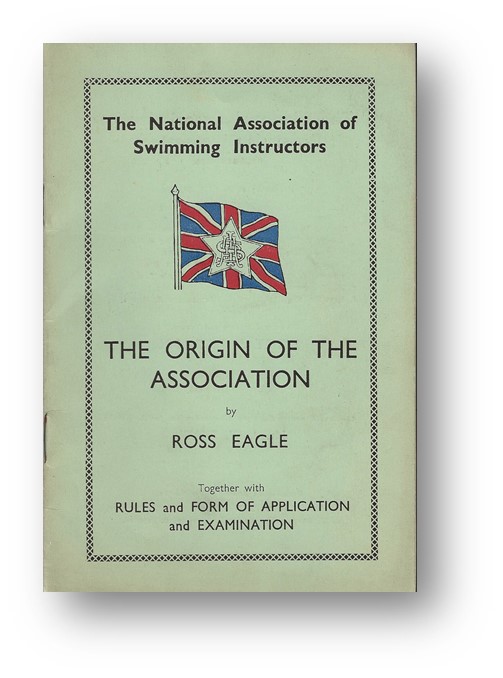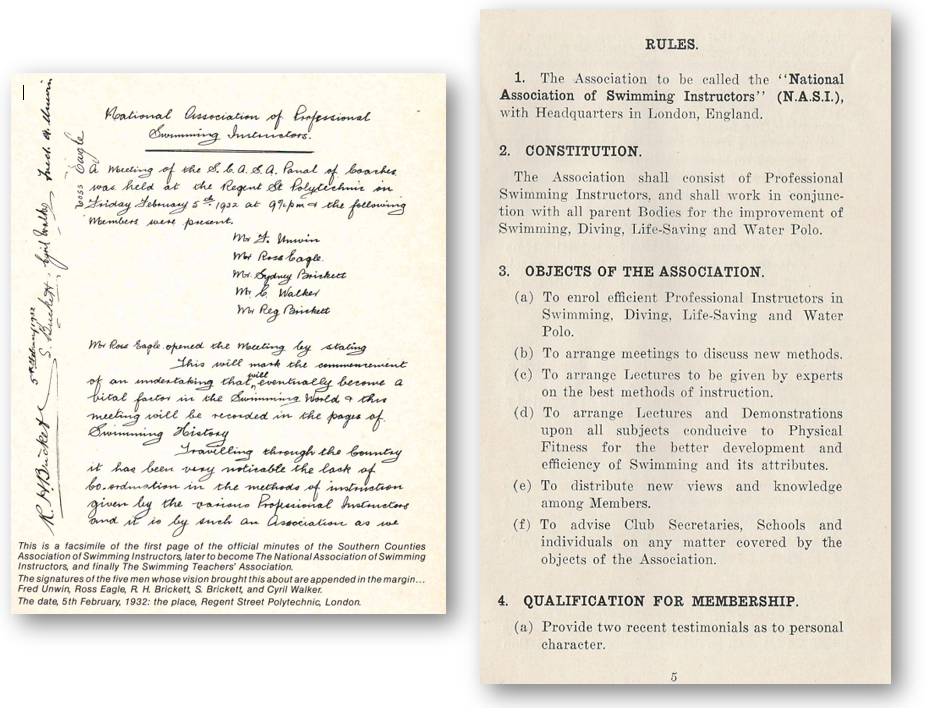Where STA Started, Back in 1932
The origins of STA – how it started, why and what it stood for – is an interesting story of how one man, named Ross Eagle, who was a member of the Croydon Swimming Club, took it upon himself to improve the teaching of swimming, and professionalise the role of swimming teachers.

Let’s go back to the beginning
In his memoirs Ross said the “the origin of the Association is reflected in the most admirable devotee to the cause of swimming, Captain B. W. Cummins”, who was then the editor of the Swimming Times. Captain Cummins suggested to members of the Croydon Swimming Clubs that subscriptions be invited to send Ross to the Olympic Games taking place in Amsterdam in 1928.
The purpose being: “Gaining knowledge in swimming strokes from the best material throughout the world gathered together for that international event, and extend the knowledge gained by that experience to the advantage of our future swimmers.”
The Borough of Croydon had three representatives competing at those Games: Phyllis Harding and Percy Peter, with Doris Grimes for diving.
While in Amsterdam, a Scotsman of the name “Robson” made things easier for Ross; he approached him and asked “I believe you are a prominent front crawl coach in England, would it be possible for us discuss each swimmer and their respective styles after each day’s session?” And indeed they did to mutual advantage, often staying up into the early hours to discuss strokes and styles, whys and wherefores, and the advantages they offered. They would also witness trainers in other countries giving their instructions to their swimmers causing more reflection upon the advantages offered to other countries, as compared to the UK, whose competitors received little help – and there was no professional coach like there was with other countries.
 Ross offered his services voluntarily to the British Olympic representatives, but they were met with a curt refusal. He said: “The curt refusal, I personally felt was very hard indeed, seeing that every representative of a country, selected to honour their country at such a time, needs encouragement and guidance when the eyes of the world of sport are upon them.”
Ross offered his services voluntarily to the British Olympic representatives, but they were met with a curt refusal. He said: “The curt refusal, I personally felt was very hard indeed, seeing that every representative of a country, selected to honour their country at such a time, needs encouragement and guidance when the eyes of the world of sport are upon them.”
On his return from the Olympics, Ross made a public report, but there it ended and it brought him to the conclusion that if swimming was to improve in the country it would undoubtedly have to come by the efforts of the people responsible for the instruction. From this he set out to organise and form a body of professional instructors – and the beginnings of the Swimming Teachers’ Association began. At first Ross said it was met with scepticism, and it was said that the professionals would never agree (Ross says in his later memoirs: what a shock those people would receive now).
Ross states the biggest task was to find a strong person in the swimming world who could lead the Association and he was fortunate to meet Mr Fred A Unwin, who at that time was the Chief Coach to the Southern Counties Amateur Swimming Association Education and Coaching Committee. Mr Unwin became the Association’s first President, and a gentleman by the name of Mr Reginald Brickett was appointed the first Honorary Secretary. Together with Ross and two more swimming enthusiasts from London – Sydney Brickett and Cyril Walker – the five of them founded the National Association of Professional Swimming Instructors in 1932.
On 5th February at 9am, the National Association of Swimming Instructors was established at the Regent Street Polytechnic in London. Ross Eagle, Fred Unwin, Sydney Brickett, Reginald Brickett and Cyril Walker founded the National Association of Professional Swimming Instructors.
 Soon after Mr Reginald Brickett found that he could not give the time to the work, and he was succeeded by Mr Henry Pike, who was then, the President of the Southern Counties Amateur Swimming Association and had been a local officer in the Thames Valley since 1918. Mr Pike played a crucial role in the early days of the Association. Ross said: “There are few officials who have been as thorough or done more for swimming during the last quarter of a century than Mr Pike and now, realising the unlimited possibilities of our Association, he has thrown himself wholeheartedly into the work of his administrative office.”
Soon after Mr Reginald Brickett found that he could not give the time to the work, and he was succeeded by Mr Henry Pike, who was then, the President of the Southern Counties Amateur Swimming Association and had been a local officer in the Thames Valley since 1918. Mr Pike played a crucial role in the early days of the Association. Ross said: “There are few officials who have been as thorough or done more for swimming during the last quarter of a century than Mr Pike and now, realising the unlimited possibilities of our Association, he has thrown himself wholeheartedly into the work of his administrative office.”
Soon after forming the Association, Ross said: “We have never looked back, indeed our progressive work grows apace to the advantage of swimming from Paignton to Edinburgh. Our members now cover the country and with such inestimable friends that are forever with us in our desire for progress and knowledge – and the enormous amount of intellectual work they are doing for us – we should, and must, become the highest standard of proficiency as swimming instructors.”
In 1946, the name of the Association changed to ‘The Swimming Teachers Association’ (due to its unfortunate post-war acronym) and sometime later changed again to be ‘The Swimming Teachers Association of Great Britain and the Commonwealth’. In the late 60s / early 70’s it reverted back to being ‘The Swimming Teachers Association’ and hasn’t changed since. Speaking at the Association’s 21st anniversary conference in 1953, the President at that time, Mr H. G. Brook, paid tribute to the five founding members, who together “decided they would like to further the interests of British Swimming so far as the Olympic Games etc. were concerned and to try and put Britain “on the map” in the swimming world.”
In twenty-one years, Mr Brook said that their ambitions had resulted in the teaching ability as a whole being welded together with far reaching effect and the status of swimming teachers as a whole considerably raised. But he added there was still more to do, in terms of raising teaching standards even higher, and increasing the salaries of swimming teachers. He also confirmed that as a result of the Association: “The children of this country are better able to swim than in any country in the world but while there are 50% of the children in the country unable to swim, efforts must not be weakened until the whole child population can do so.”
During his speech Mr Brook then says something that firmly resonates with STA’s principles today “We must continue to pull together and work together so that our ideals may be achieved,” and … “this can only be done by absolute co-operation”.
Dave Candler, STA’s CEO says: “STA continues to value these principles of co-operation and working together; with our members, swim schools, likeminded industry bodies and corporate partners – our STA Family – let’s continue to work together for another 90 years, for the greater good of swimming teaching, and to ensure we can teach as many learners as possible a key life skill, just like our founders and members did before us.”

